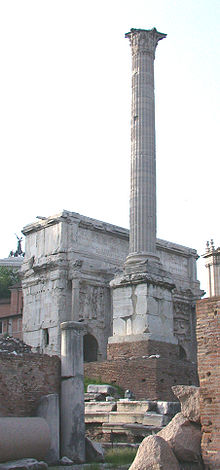- Column of Phocas
-
The Column of Phocas (Italian: Colonna di Foca), is a Roman monumental column in the Roman Forum of Rome, Italy. Erected before the Rostra and dedicated or rededicated in honour of the Eastern Roman Emperor Phocas on August 1, 608, was the last addition made to the Forum Romanum. The fluted Corinthian column stands 13.6 m (44 ft) tall on its cubical white marble socle and seems originally to have been made about the 2nd century. The square foundation of brick (illustration, right) was not originally visible, the present level of the Forum not having been excavated down to its earlier Augustan paving until the 19th century.
The precise occasion for this signal honour is unknown, though Phocas had formally donated the Pantheon to Pope Boniface IV, who rededicated it to all the Martyr Saints—to whom Mary was added in the Middle Ages (Santa Maria ad Martyres). Atop the column's capital was erected by Smaragdus, the Exarch of Ravenna, a "dazzling" gilded statue of Phocas (which probably only briefly stood there).
In October 610, Phocas, a low-born usurper himself, was treacherously captured, tortured, assassinated and grotesquely dismembered: his statues everywhere were overthrown.
Rather than a demonstration to mark papal gratitude as it is sometimes casually declared to be, the gilded statue on its column was more likely an emblem of the imperial sovereignty over Rome, which was rapidly fading under pressure from the Lombards, and a personal mark of gratitude from Smaragdus, who had been recalled by Phocas from a long exile and was indebted to the Emperor for retrieving his position of power at Ravenna.
The base of the column was uncovered in 1813, and the inscription on it reads, in Latin:
Optimo clementiss[imo piissi]moque / principi domino n[ostro] / F[ocae imperat]ori / perpetuo a d[e]o coronato, [t]riumphatori / semper Augusto / Smaragdus ex praepos[ito] sacri palatii / ac patricius et exarchus Italiae / devotus eius clementiae / pro innumerabilibus pietatis eius beneficiis et pro quiete / procurata Ital[iae] ac conservata libertate / hanc sta(tuam maiesta)tis eius / auri splend(ore fulge)ntem huic / sublimi colu(m)na(e ad) perennem / ipsius gloriam imposuit ac dedicavit / die prima mensis Augusti, indict[ione] und[icesima] / p[ost] c[onsulatum] pietatis eius anno quinto
The English translation is as follows:
To the best, most clement and pious ruler, our lord Phocas the perpetual emperor, crowned by God, the forever august triumphator, did Smaragdus, former praepositus sacri palatii and patricius and Exarch of Italy, devoted to His Clemency for the innumerable benefactions of His Piousness and for the peace acquired for Italy and its freedom preserved, this statue of His Majesty, blinking from the splendor of gold here on this tallest column for his eternal glory erect and dedicate, on the first day of the month of August, in the eleventh indiction in the fifth year after the consulate of His Piousness.
The column was recycled from its original earlier use supporting a statue dedicated to Diocletian: the former inscription was chiselled away to provide a space for the present effusion.
The column remains in situ. Its isolated, free-standing position among the ruins has always made it a landmark in the Forum, and it often appears in vedute and engravings. The rise in ground level due to erosion had completely buried the socle by the time Giuseppe Vasi and Giambattista Piranesi made engravings and etchings of the column in the mid-18th century.
See also
External links
- René Seindal, "The Column of Phocas"
- Encyclopaedia Romana "Column of Phocas"
- The Column of Phocas, a novel by Sean Gabb.
- Christian Hülsen, 1906. The Roman Forum: Its History and Its Monuments "The Column of Phocas"
Coordinates: 41°53′33″N 12°29′05″E / 41.8925°N 12.48472°E
- Column of Antoninus Pius
- Column of Marcus Aurelius
- Column of Phocas
- Trajan's Column
List of Roman victory columns Categories:- Buildings and structures completed in the 7th century
- Roman victory columns
- Monumental columns in Rome
- 600s architecture
Wikimedia Foundation. 2010.

